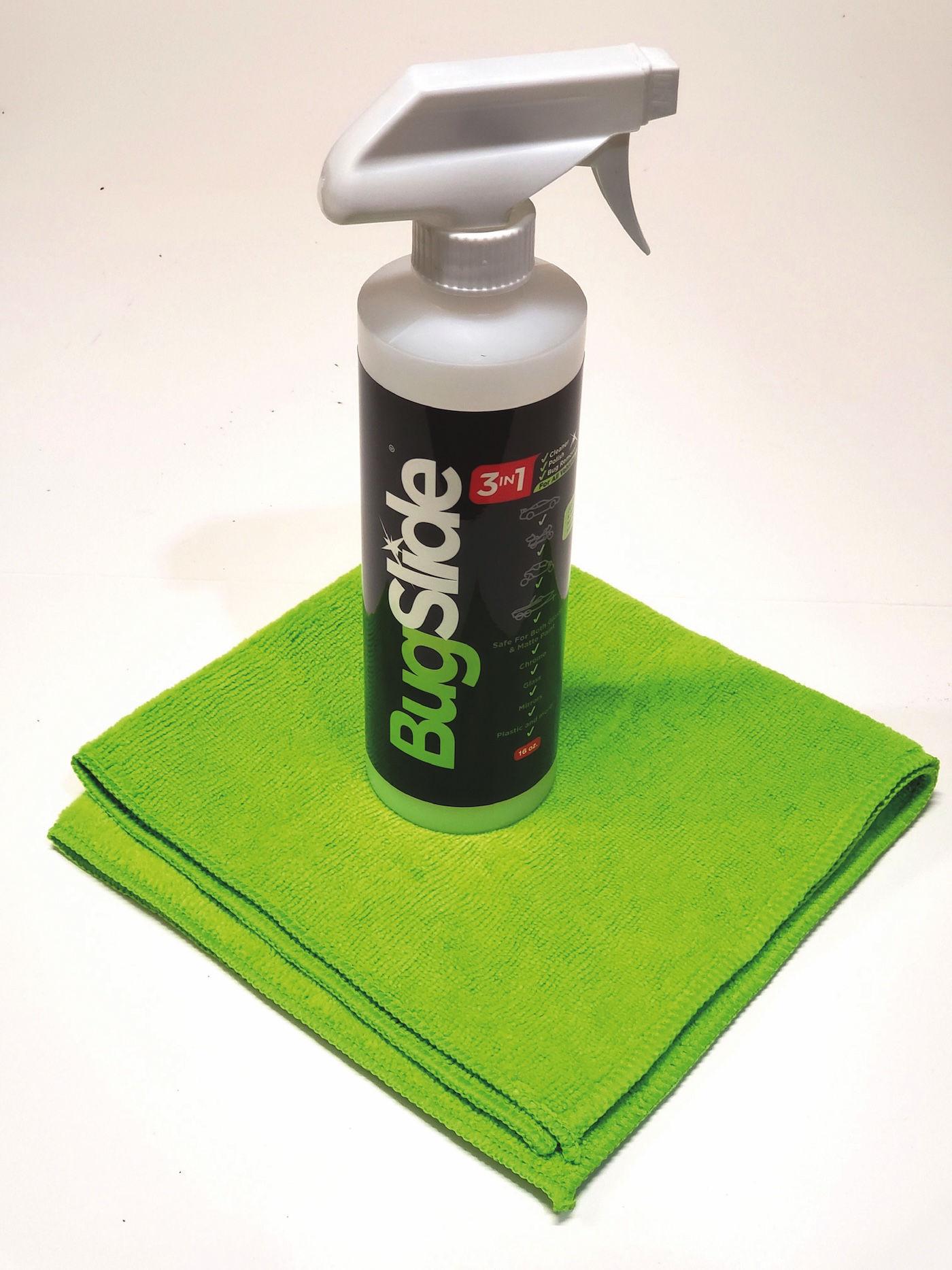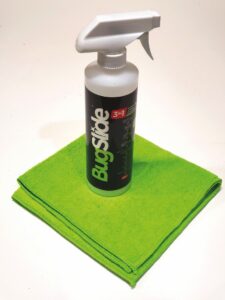At every MOA National Rally, I’m vigilant for new products that might be worth a report to the membership–preferably something clever and unexpected. I especially appreciate “better mousetraps” that meet a familiar need in an unfamiliar way. I found just such a surprise offered by one of the vendors in Lebanon, Tenn., this year: BugSlide spray, touted as a multi-function, waterless, non-aerosol solution to problems associated with riding a motorcycle in the great outdoors–specifically the accumulation of crusty bug guts and grungy grime on our beloved machines and vitally important helmet visors.
A crucial consideration in approaching the removal of such gunk is the possibility of damaging the underlying surfaces. Some common cleaning chemicals can cloud clear plastics, others might discolor paint or compromise clearcoats. Certain items, like iridium face shields, can be especially finicky, degrading quickly with repeated cleanings and often streaking in the absence of precise technique. Purportedly 100% safe for all non-porous, non-rubber surfaces, and yet also claimed to quickly and effortlessly dissolve virtually any expectable contaminant, the BugSlide pitch sounded too good to be true. But watching the salesman successfully demonstrate its effectiveness on the helmets of nearby rally-goers convinced me to give it a try–at least it dispatched bugs with ease!

Convenience is a big selling point for this kind of product, and it’s really two-fold. First, there’s how easy a cleaner is to apply (e.g., does it require rinsing afterward or lots of buffing?). Second is if it reduces the effort needed during future cleanings. BugSlide addresses both of these issues with a proprietary polymer formula free of silicone, wax, solvents or other harsh cleansers. I don’t pretend to understand how such chemicals work, but–per the salesman–this one has been designed to break down the proteins that make insect innards stick together, along with the molecular bonds that make other substances cling to surfaces–all while simultaneously depositing a durably lustrous, crystal-clear coating that interferes with subsequent adhesions and filters UV rays. The result should be a beautifully shiny surface that is easier to clean the next time around. Note: when using BugSlide on a surface with satin or matte finish, the original character is maintained; it will not impart an artificial sheen (as does Armor All, for example) that would interfere with the part’s intended aesthetic.
Fortunately for the purpose of this evaluation, current conditions where I live are hot, muggy, and ripe for the airborne festivities of a wide variety of bugs, everything from big-and-juicy to hard-and-tiny. There has also been plenty of rain, making a silty film of road spray common on my bikes’ exteriors. My motorcycles feature all sorts of surface finishes, as well as windshields from different manufacturers. My helmets are outfitted with conventional clear and smoked visors, along with some photochromatic and iridium variants. I have chain-drive bikes that perpetually deposit some of the associated lube on their rear wheels (despite supposedly “anti-fling” formulations), and even the shaft-drive model returns from every ride with a coating of brake dust on its rims. I’ve used many, many waterless cleaners and polishes over the past half-century and detail my motorcycles frequently. I like to keep them looking their best, but the more important motivation is detecting any new problems as promptly as possible. All that to say this: the context of this evaluation has included tough environmental factors, a broad range of applications, and a picky user with tons of cleaning experience. I doubt there could be a more thorough or challenging test of BugSlide’s effectiveness. Does it work as advertised? In short, yes!
Safety first. I detected no negative impact whatsoever upon any of the surfaces cleaned, and I put it on everything but the tires and brake disks. BugSlide didn’t change any original finish’s visual characteristics, but left everything clean and slippery to the touch–not at all oily, but noticeably slicker than prior to use. The package I purchased included a trigger-spray bottle of BugSlide and a bright green microfiber towel, the latter of which is soft and gentle on delicate surfaces (like any plush microfiber cloth). While BugSlide itself won’t hurt your precious surfaces, the cloth you use could have abrasive fibers, so a high-quality microfiber version is definitely recommended. Also, BugSlide isn’t meant to remove thick layers of dirt or mud, so you’ll still have to wash such residue off with a hose to avoid gritty buildup on your cleaning cloth. And, regardless of what cleaner you use, it’s best to let hardened bugs soften before dragging them across your visor or windshield. BugSlide suggests waiting about 30 seconds after spraying to wipe, longer in extreme cases.
While BugSlide performed admirably on bugs, brake dust and road film, it didn’t work as well as some other products (e.g., my long-time personal fave, ProtectAll) on chain lube or similar sticky petroleum-based buildup; it’s just not a hard-core degreaser and requires multiple applications to break down resinous goop. That said, it does perfectly fine on a little spilled fuel or oil, or even a light smattering of chain lube mist, and once a surface had been treated with BugSlide, petroleum-based contaminants seemed easier to remove with any cleaner. This was also true for bugs and other crud. Subsequently collected dust of all sorts could be wiped off using only a dry cloth, although doing so risks scratching fragile finishes if the cloth isn’t thick enough to scoop up particles and hold them away from the surface being cleaned.
As for value, BugSlide is on the expensive side of this product category. The 16-ounce spray bottle and 16” x 16” microfiber towel package I bought is available online for $22 plus shipping, or $29 with free shipping, depending on the vendor. Many additional options are offered, with bottle sizes ranging from 4 oz. to 2.5 gal., with and without microfiber towels. For comparison, a 16 oz. spray bottle of ProtectAll costs $15.39 on Amazon (which may or may not include shipping, depending on the size of your order and your Prime status) and you’ll have to supply your own cleaning cloth (good microfiber towels like the one from BugSlide are readily available for less than two bucks apiece). To be fair, ProtectAll doesn’t dissolve bugs as efficiently as BugSlide and its slightly more viscous consistency requires considerably more wiping to remove after application; it will also produce a potentially unwelcome sheen on matte finishes and contains carnauba wax, as opposed to the more sophisticated polymer chemistry in BugSlide.
There are a multitude of other waterless detailers available for less than BugSlide’s premium pricing, but I haven’t found one that works as well on bug splatter or wipes off as quickly and completely. It’s hard to judge without laboratory conditions, but the protective coating deposited by BugSlide seems longer lasting than most. If you routinely collect a great many insects on your motorcycle and visor, and you don’t usually coat your rear wheel in chain lube, BugSlide is probably worth the extra money. I plan to use it for most of my bike and helmet cleaning, while keeping ProtectAll on hand for any greasy messes.







